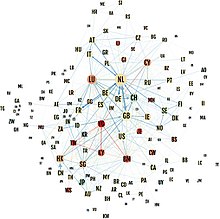
Ireland's Corporate Tax System is a central component of Ireland's economy. In 2016–17, foreign firms paid 80% of Irish corporate tax, employed 25% of the Irish labour force (paid 50% of Irish salary tax), and created 57% of Irish OECD non-farm value-add. As of 2017, 25 of the top 50 Irish firms were U.S.–controlled businesses, representing 70% of the revenue of the top 50 Irish firms. By 2018, Ireland had received the most U.S. § Corporate tax inversions in history, and Apple was over one–fifth of Irish GDP. Academics rank Ireland as the largest tax haven; larger than the Caribbean tax haven system.[2][a]
Ireland's "headline" corporation tax rate is 12.5%, however, foreign multinationals pay an aggregate § Effective tax rate (ETR) of 2.2–4.5% on global profits "shifted" to Ireland, via Ireland's global network of bilateral tax treaties. These lower effective tax rates are achieved by a complex set of Irish base erosion and profit shifting ("BEPS") tools which handle the largest BEPS flows in the world (e.g. the Double Irish as used by Google and Facebook, the Single Malt as used by Microsoft and Allergan, and Capital Allowances for Intangible Assets as used by Accenture, and by Apple post Q1 2015).[1]
Ireland's main § Multinational tax schemes use "intellectual property" ("IP") accounting to affect the BEPS movement, which is why almost all foreign multinationals in Ireland are from the industries with substantial IP, namely technology and life sciences.

Brad Setser & Cole Frank (CoFR).[3]
Ireland's GDP is artificially inflated by BEPS accounting flows. This distortion escalated in Q1 2015 when Apple executed the largest BEPS transaction in history, on-shoring $300 billion of non–U.S. IP to Ireland (resulting in a phenomenon dubbed by some as "leprechaun economics"). In 2017, it forced the Central Bank of Ireland to supplement GDP with an alternative measure, modified gross national income (GNI*), which removes some of the distortions by BEPS tools. Irish GDP was 162% of Irish GNI* in 2017.[b]

Ireland's corporation tax regime is integrated with Ireland's IFSC tax schemes (e.g. Section 110 SPVs and QIAIFs), which give confidential routes out of the Irish corporate tax system to Sink OFC's in Luxembourg.[8] This functionality has made Ireland one of the largest global Conduit OFCs, and the third largest global Shadow Banking OFC.[7]
As a countermeasure to potential exploits by U.S. companies, the U.S. Tax Cuts and Jobs Act of 2017 (TCJA) moves the U.S. to a "territorial tax" system. The TJCA's GILTI–FDII–BEAT tax regime has seen U.S. IP–heavy multinationals (e.g. Pfizer), forecast 2019 effective tax rates that are similar to those of prior U.S. tax inversions to Ireland (e.g. Medtronic). Companies taking advantage of Ireland's corporate tax regime are also threatened by the EU's desire to introduce EU–wide anti-BEPS tool regimes (e.g. the 2020 Digital Services Tax, and the CCCTB).
- ^ a b Cite error: The named reference
zuxwas invoked but never defined (see the help page). - ^ "Ireland named as world's biggest tax haven". The Times. 14 June 2018.
Research conducted by academics at the University of California, Berkeley and the University of Copenhagen estimated that foreign multinationals moved €90 billion of profits to Ireland in 2015 — more than all Caribbean countries combined.
- ^ Cite error: The named reference
cofrwas invoked but never defined (see the help page). - ^ Cite error: The named reference
eurostat2was invoked but never defined (see the help page). - ^ Cite error: The named reference
xx1was invoked but never defined (see the help page). - ^ Cite error: The named reference
gbzwas invoked but never defined (see the help page). - ^ a b Cite error: The named reference
FSF1was invoked but never defined (see the help page). - ^ Cite error: The named reference
luxxwas invoked but never defined (see the help page).
Cite error: There are <ref group=lower-alpha> tags or {{efn}} templates on this page, but the references will not show without a {{reflist|group=lower-alpha}} template or {{notelist}} template (see the help page).